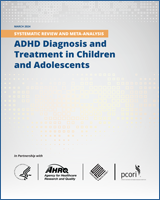From: 4, Results: Diagnosis of ADHD

NCBI Bookshelf. A service of the National Library of Medicine, National Institutes of Health.
| KQ1 Diagnostic Test | Outcome | Number of Studies and IDs | Findings | Reasons for Downgrading | SoE |
|---|---|---|---|---|---|
| KQ1 Teacher Ratings | Sensitivity | 17 studies18, 119, 183, 218, 242, 299, 301, 314, 359, 479, 482, 527, 528, 558, 559, 587, 642 |
Sensitivity ranged from 70% using the BASC-3 (corresponding specificity 73%)642 to 92% using the ADHD-RS (corresponding specificity 88%)299 differentiating ADHD and neurotypical development Sensitivity ranged from 40% using the SNAP-IV (corresponding specificity 71%)482 to 97% using the SNAP-IV (corresponding specificity 26%)314 in clinical samples | S, I | Low |
| KQ1 TRF | Sensitivity | 3 studies242, 301, 587 | Reported sensitivity ranged from 72% (corresponding specificity 75%)301 to 79% (corresponding specificity 64%)587 | S, C | Low |
| KQ1 SNAP-IV | Sensitivity | 2 studies314, 482 | Reported sensitivity ranged from 40% (corresponding specificity 71%)482 to 97% (corresponding specificity 26%)314 | S, C | Low |
| KQ1 Teacher Ratings | Specificity | 16 studies18, 119, 183, 218, 242, 299, 301, 314, 359, 482, 527, 528, 558, 559, 587, 642 |
Specificity ranged from 55% using the DBD (corresponding sensitivity 82%)528 to 88% for the ADHD-RS (corresponding sensitivity 92%)299 differentiating ADHD and neurotypical development Specificity ranged from 48% using the CTRS-R (corresponding sensitivity 82%)183 to 91% for the TRF aggressive behavior scale (corresponding sensitivity 48%)301 in clinical samples | S, I | Low |
| KQ1 TRF | Specificity | 4 studies242, 301, 342, 587 | Reported specificity ranged from 64%587 to 76%242 | S, C | Low |
| KQ1 SNAP-IV | Specificity | 2 studies314, 482 | Reported specificity ranged from 26% (corresponding sensitivity 97%)314 to 71% (corresponding sensitivity 40%)482 | S, C | Low |
| KQ1 Teacher Ratings | Accuracy | 4 studies18, 299, 559, 587 |
Accuracy was 91%299 using the ADHD-RS to differentiate ADHD and neurotypical development Accuracy ranged from 69 using the ECI-4559 to 76% using the TRF587 in clinical samples | C | Low |
| KQ1 Teacher Ratings | AUC | 5 studies218, 301, 342, 359, 479 |
AUC was 0.83 using the BASC-2359 differentiating ADHD and neurotypical development AUC ranged from 0.65 for TRF342 to 0.84 for the ADHD RS-IV teacher rating inattention scale479 in clinical samples | S, I | Low |
| KQ1 TRF | AUC | 2 studies301, 342 | AUC ranged from 0.65%342 to 0.77 when combined with Conners-3-T(S)301 | S, C | Low |
| KQ1 Teacher Ratings | Rater agreement | 4 studies218, 362, 391, 463 |
In clinical samples: Correlations between teacher and parent ratings ranged from 0.17 to 0.41 over four subscales on the CHAOS scale,391 the reported kappa range was 0.29 between teacher and parent ratings on the ADHD RS-IV,362 up to 0.68 for Symptom Inventories Teacher rating463; ICCs comparing teacher and parent scores of the Conners rating scales were 0.19218 | S, I | Low |
| KQ1 Teacher Ratings | Internal consistency | 6 studies218, 342, 359, 391, 527, 528 |
In neurotypical samples: Cronbach’s alpha 0.94 for both teacher-rated inattention and hyperactivity symptom counts on the DBD528 Cronbach’s alpha was 0.95 for BASC-2359 Cronbach’s alpha was 0.94 for the DBD527 In clinical samples: Cronbach’s alpha was 0.95 for the TRF attention problems subscale342; Cronbach’s alpha ranged from 0.64 to 0.91 over four subscales of the CHAOS scale391, Cronbach’s alpha was 0.80 for CTRS-R218 | S, I | Low |
| KQ1 Teacher Ratings | Test-retest reliability | 1 study391 | Pearson correlations ranged from 0.74 to 0.87 over four subscales of the CHAOS scale, retest between 1 and 829 days391 in a clinical sample | C | Low |
| KQ1 Teacher Ratings | Misdiagnosis impact | 0 studies | No data | C | Insufficient |
| KQ1 Teacher Ratings | Costs | 0 studies | No data | C | Insufficient |
Notes: AUC = area under the curve, KQ = Key Question, Attention-Deficit/Hyperactivity Disorder Rating Scale, 4th edition, ASEBA = Achenbach System of Empirically Based Assessment, BASC = Behavior Assessment System for Children, C = inconsistency, CHAOS = Hyperactive-Attention Problem- Oppositional Symptom, CTRS-R = Connor Teacher Rating Scale Revised, DBD = Disruptive Behavior Disorder rating scale, I = imprecision, S = study limitation, SNAP-IV = Swanson, Nolan, and Pelham Questionnaire, SoE = strength of evidence, TRF = Teacher Report Form
From: 4, Results: Diagnosis of ADHD

NCBI Bookshelf. A service of the National Library of Medicine, National Institutes of Health.